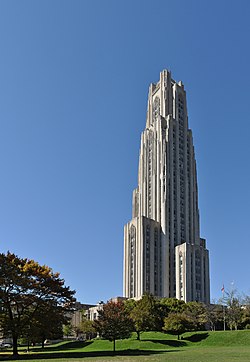Cathedral of Learning
|
Cathedral of Learning
|
|

The Cathedral of Learning at the University of Pittsburgh
|
|
| Location | Pittsburgh, Pennsylvania, USA |
|---|---|
| Coordinates | 40°26′39″N 79°57′11″W / 40.44417°N 79.95306°WCoordinates: 40°26′39″N 79°57′11″W / 40.44417°N 79.95306°W |
| Built | 1926 |
| Architect | Charles Klauder |
| Architectural style | Late Gothic Revival with some Art Deco influences |
| Part of | Schenley Farms Historic District (#83002213) |
| NRHP Reference # | 75001608 |
| Significant dates | |
| Added to NRHP | November 3, 1975 |
| Designated CP | July 22, 1983 |
| Designated CPHS | February 22, 1977 |
| Designated PHLF | 1970: Croghan-Schenley Ballroom 1972: Cathedral of Learning interiors 1973: Cathedral of Learning |
The Cathedral of Learning, a Pittsburgh landmark listed in the National Register of Historic Places, is the centerpiece of the University of Pittsburgh's main campus in the Oakland neighborhood of Pittsburgh, Pennsylvania, United States. Standing at 535 feet (163 m), the 42-story Late Gothic Revival Cathedral is the tallest educational building in the Western hemisphere and the second tallest university building (fourth tallest educationally-purposed building) in the world. It is also the second tallest gothic-styled building in the world. The Cathedral of Learning was commissioned in 1921 and ground was broken in 1926. The first class was held in the building in 1931 and its exterior finished in October 1934, prior to its formal dedication in June 1937.
Colloquially referred to as "Cathy" by Pitt students, the Cathedral of Learning is a steel frame structure overlaid with Indiana limestone and contains more than 2,000 rooms and windows. It functions as a primary classroom and administrative center of the university, and is home to the Dietrich School of Arts and Sciences and many of its departments, as well as the University Honors College. It served as home of the university's College of General Studies until its relocation to Posvar Hall in 2014. It houses many specialty spaces, including a studio theater, food court, study lounges, offices, computer and language labs, 30 Nationality Rooms, and a 1⁄2-acre (2,000 m2), 4-story-high, vaulted, gothic study and event hall. The building contains noted examples of stained glass, stone, wood, and iron work and is often used by the university in photographs, postcards, and other advertisements.
The basement and floors up to (and including) floor 40 are used for educational purposes, although most floors above 36 house the building's mechanical equipment. These floors include theaters, computer laboratories, language laboratories, classrooms, and departmental offices. The basement contains a black box theater and the ground floor contains computer labs, language labs, classrooms, and the Cathedral Café food court. The "lobby", comprising the first through third floors, contains a massive gothic "Commons Room" that is used as a general study area and for special events and is ringed by three floors of classrooms, including, on the first and third floors, the 30 Nationality Rooms designed by members of the Pittsburgh community in the styles of different nations and ethnic groups. Twenty-eight of these serve as functional classrooms while more conventional classrooms are located on the second floor and elsewhere throughout the building. The first floor also serves as the home to the offices of the Chancellor, Executive Vice Chancellor, and other administration offices, as well as the Nationality Rooms Gift Shop. The fourth floor, which used to be home to the main stacks of the university's library, is now occupied by the McCarl Center for Nontraditional Student Success. The fifth floor originally housed the main borrowing, reference, and reading rooms of the university library, and now houses the Department of English. The Pitt Humanities Center is housed on the sixth floor. Additionally, the University Honors College is located on the 35th and 36th floors.
...
Wikipedia



